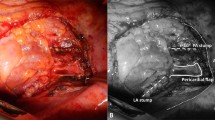Abstract
Introduction. Bronchoplastic procedures have become established in the treatment of bronchial malignancies. We report our results on 108 operations performed between 1994 and 2001.
Patients and methods. Bronchial reconstruction techniques (wedge resection, end-to-end-anastomosis, y-sleeve), comorbidity (cardiovascular, respiratory, pulmonary, neoadjuvant chemotherapy, alcoholism), postoperative complications (septic/aseptic, light/severe), histology, tnm-stage and postoperative follow up (days) were recorded prospectively.
Results. The bronchial tree was reconstructed with an end to end anastomosis in 75 cases (69.4%), a y-sleeve in 17 (15.7%) and a wedge resection in 16 (14.8%). In 11 patients (10.2%), an additional angioplasty of the pulmonal artery was performed. The comorbidity rate was 89.8%. A total of 52 patients (49.1%) presented with one or more cardiovascular risk factors and 84 patients (77.8%) with one or more respiratory risk factors. The overall postoperative morbidity was 26.8% and the mortality 5.5%. Aseptic complications were observed in 12 cases (11.1%) with a mortality of 25% while septic complications occurred in 17 patients (15.7%) with a mortality of 17%. Anastomotic fistulas occurred in three patients (2.8%) and pneumonia in 11 (10.2%). Stage I was found in 46 patients (42.6%), 29 (26.8%) had stage II, 21 (19.5%) stage IIIA, five (4.6%) stage IIIB and two had stage IV (1.8%). The follow up period ranged from 64 to 2,654 days (mean 756.42±643.46, median 575.0). Seven patients (6.5%) died with no evidence of disease. After 2 years, 65% of all patients were alive, after five years this had dropped to 50%.
Conclusion. Bronchoplastic procedures are a safe method for the treatment of bronchial malignancies, even in cases with high comorbidity, and should be performed whenever possible.
Zusammenfassung
Einleitung. Bronchoplastische Resektionen sind als Standardtherapie bronchialer Malignome etabliert. Wir analysieren unsere prospektiv dokumentierten Ergebnisse an 108 Patienten, die zwischen 1994 und 2001 operiert wurden.
Methoden. Prospektive Dokumentation der Operationstechnik, Begleitmorbidität (kardiovaskuläre, respiratorische und pulmonale Begleiterkrankungen, neoadjuvante Chemotherapie, Alkoholismus), Komplikationen (septisch/aseptisch, leicht/schwer), Histologie und Tumorstadien sowie Nachbeobachtung.
Ergebnisse. Der Bronchus wurde in 75 Fällen (69,4%) mit einer End-zu-End-Anastomose rekonstruiert, in 17 Fällen (15,7%) erfolgte eine Replantation eines Lappenbronchus in den Hauptbronchus, bei 16 Patienten (14,8%) wurde eine reine Keilexzision am Bronchus durchgeführt. Bei 11 Patienten (10,2%) wurde zusätzlich die A. pulmonalis rekonstruiert. Die Gesamtkomorbidität betrug 89,8%. Bei 52 Patienten (49,1%) lagen einer oder mehrere kardiovaskuläre Risikofaktoren vor, einer oder mehrere respiratorische Risikofaktoren bei 84 (77,8%). Die postoperative Gesamtmorbidität betrug 26,8%, die Letalität 5,5%. Aseptische Komplikationen traten bei 12 Fällen (11,1%) mit einer Letalität von 25% auf, septische Komplikationen bei 17 Patienten (15,7%) mit einer Letalität von 17%. Die Anastomoseninsuffizienzrate betrug 2,8%, eine postoperative Pneumonie trat bei 10,2% unserer Patienten auf. Stadium I lag bei 46 Patienten (42,6%) vor, Stadium II bei 29 (26,8%), Stadium IIIA bei 21 (19,5%), Stadium IIIB bei 5 (4,6%) und Stadium IV bei 2 (1,8%). Die Nachbeobachtungsdauer betrug 64–2.654 Tage (Mittelwert 756,42±643,46, Mediane 575,0). Sieben Patienten (6,5%) verstarben tumorfrei. Die Zweijahresüberlebensrate betrug 65%, die Fünfjahresüberlebensrate 50%.
Schlussfolgerung. Bronchoplastische Operationen sind eine sichere Methode zur Behandlung pulmonaler Neoplasmen und sollten in jedem Fall durchgeführt werden, wenn es die lokale anatomische Situation erlaubt. Auch bei hoher Komorbidität sind gute Ergebnisse zu erzielen.
Similar content being viewed by others
Author information
Authors and Affiliations
Additional information
Dr. P.H. Hollaus Thoraxchirurgische Abteilung, Otto Wagner Krankenhaus, Sanatoriumstraße 2, 1140 Wien, Österreich, E-Mail: Peter.Hollaus@PUL.magwien.gv.at
Rights and permissions
About this article
Cite this article
Hollaus, P., Wurnig, P. & Pridun, N. Bronchoplastische Resektionen in der Behandlung maligner Lungentumoren. Chirurg 73, 1115–1122 (2002). https://doi.org/10.1007/s00104-002-0520-7
Issue Date:
DOI: https://doi.org/10.1007/s00104-002-0520-7




